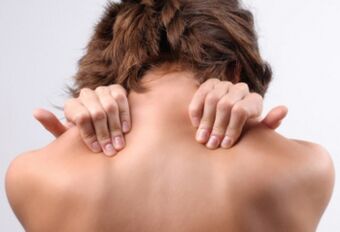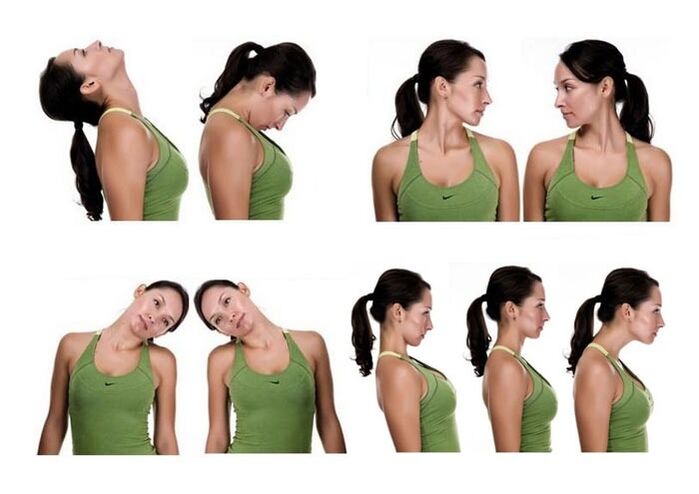
Few of the modern people have heard of osteochondrosis. Most of them have experienced the symptoms of this disease on several occasions. Wide spread of the disease is associated with prolonged sitting at computer, inactive lifestyle, improper diet etc. Has happened. Osteochondrosis of the cervical spine is manifested by pain, muscle weakness, limited mobility and a whole range of other symptoms.
Do not ignore the symptoms of osteochondrosis, because the sooner you start treatment, the faster you will be able to get rid of the disease. In the initial stages, conservative therapy is carried out: taking medications, exercise therapy, physiotherapy, massage, etc. When complications appear and destruction of the bone-cartilaginous structure occurs, an operation is prescribed.
What is this
Osteochondrosis of the neck is a pathology that occurs only in humans. Animals do not suffer from it. This is due to the vertical position of the spine. In this position, the vertebrae squeeze each other, which leads to the fact that the intervertebral discsSlowly it gets destroyed.
The cervical region consists of 7 vertebrae, separated from each other by discs. This segment of the spine is quite mobile, which is why it is one of the most vulnerable areas of the spinal column. The weakest of the cervical spineThe hard intervertebral disc, which shows mainly degenerative-dystrophic changes.
The prevalence of cervical osteochondrosis is also explained by a weak muscle corset in the neck. In addition, small vertebrae are located in this area, they have a different structure and fit very tightly to each other. That is why on the neckEven a small load can provoke their displacement, as well as compression of blood vessels and nerve branches. When the vertebral artery located inside the spinal cord in this area is pinched, dangerous complications arise. Huh.
Osteochondrosis of the cervical spine (CS) is threatened with protrusions (displacement of the nucleus pulposus without damage to the outer shell) and disc herniation. These formations compress nerve bundles, blood vessels.
Due to degenerative changes in the intervertebral discs, there is an increased likelihood of the presence of bone growths (osteophytes) in the areas of the vertebral joints. Because of this, the intervertebral canal narrows and the neurovascular structures become compressed.
Context. According to medical data, people over 35 years old are more likely to suffer from cervical osteochondrosis. Although now there is a rejuvenating pathology, which most often develops in patients over the age of 20. It is mainlyThis is due to sedentary lifestyle and poor diet.
Doctors identified 4 stages of pathology:
- 1st degree - the cartilaginous lining between the vertebrae begins to collapse. At this stage, the disease has eradicated the symptoms. Unfortunately, patients do not notice them.
- 2 degree - under the pressure of the vertebrae, the height of the disc decreases, the integrity of its outer shell is violated. At this stage, protrusions may appear. Pain appears, the mobility of the neck is limited, and the facesensitivity may be impaired.
- Grade 3 - the protrusions turn into hernias, which compress blood vessels and muscles. In addition to the pain syndrome, there is pain in the back of the head, dizziness.
- 4 degree - osteophytes are formed, which immobilize the vertebrae, but pinch the nerve fibers. The pain does not disappear, there is stiffness of movements, neighboring vertebrae are damaged, and neurological symptoms appear.
It is important to start treatment in stages 1 - 2 to avoid serious complications that can only be corrected surgically.
reason
Osteochondrosis shop is a complex and lengthy process that can occur under the influence of many negative factors.
For example, in older people, the disease is associated with age-related changes in the body. Then degenerative-dystrophic changes occur as a result of local blood circulation, disruption of metabolic processes, weakening of immunity.
However, doctors identified the main causes of cervical osteochondrosis:
- poor posture.
- Curvature of the spinal column.
- Cervical segment injuries.
- excessive weight.
- exhausting physical labor.
- Sitting at the computer for a long time.
- inactive lifestyle.
- Violation of metabolic processes.
- Frequent hypothermia of the neck.
- Improper organization of the sleeping place (too soft mattress, high pillow).
- Frequent stress, chronic fatigue.
- Congenital malformation of the shop structure.
- Autoimmune diseases that cause cartilage degeneration.
- Infection.
- Features of body parts, such as a very long or short neck.
Under the influence of these factors, intervertebral structures, bone tissue begin to collapse, nerve bundles and blood vessels are damaged.
Symptoms
The clinical picture of osteochondrosis of the cervical spine (OSHOP) is diverse. This makes it difficult for patients to understand what is happening to them. They attribute the early manifestations of the disease to overwork. And pronounced symptomsAfter the onset of the disease, they turn to the doctor, but in this case, irreversible changes are already present and it will no longer be possible to restore the structure of the cervical spine.

The main symptoms of osteochondrosis of the cervical spine:
- Feeling of pain in neck, shoulders.
- Weakness of the muscles around the affected part of the spine.
- excessive sweating.
- Violation of the sensitivity of the upper limbs.
- Movement coordination disorder.
- Cephalalgia (headache).
- Dizziness (dizziness).
- Hearing and vision disorders.
- Blood pressure rises, etc.
The nature of the headache in osteochondrosis is different: paroxysmal, constant, pulsating, dull. This symptom appears due to spasm of cerebral vessels, compression of the nerve bundles of the cervical spine and increased intracranial pressure.
With OSHOP, pain in the region of the cervical segment does not always appear, it can spread to the shoulders and arms. Discomfort after sleep, sudden movements, tension in the neck, for example, when coughing or sneezing can occur.
With osteochondrosis of the shop, an increase in pressure is observed depending on the time of day, constant hypertension is uncharacteristic for pathology. Usually, with an increase in pressure, the following manifestations are observed: cephalgia, pain in the hands, cervical-Numbness of the collar area. Pressure drops are often seen after nerve or muscle tension, prolonged uncomfortable posture.
Cervical osteochondrosis syndrome
Several syndromes (specific conditions with specific symptoms) are seen in OSHOP. Their manifestation depends on which nerve branches and vessels are damaged.
Cervical osteochondrosis syndrome:
- Vertebral artery - occurs as a result of compression or irritation of the artery that feeds the brain. Then the patient starts having hearing impairment, vision, dizziness, pressure drops, migraine etc.
- Cardiac - develops when the nerve bundles that innervate the diaphragm or pectoral muscle are compressed. Then there is a burning sensation in the chest, shortness of breath, weakness, increased heart rate.
- Hypertension - occurs due to compression of the veins, due to which the outflow of blood from the head is obstructed. Then intracranial pressure rises, the patient has a headache, nausea, vomiting.
- Cervical migraine - caused by compression of the nerves around the vertebral artery. Then there is a migraine-like pain in the back of the head. The attack lasts about 10 hours and is often accompanied by an eruption of vomiting.
- The most common symptom complex in radicular OSHOP. It is caused by compression of one of the nerve bundles in the vertebrae of the cervical segment. If the conduction of 1-2 roots of the cervical vertebrae is disturbed, there is a loss of sensitivity or a loss of sensation of the head. Back pain. If 3 pairs are damaged, tongue becomes numb, area behind ear, it is difficult for the person to chew food. Pain in collarbone with swelling of 4 pair roots, hiccups, swallowingIf the conduction of 5 - 8 pairs of nerve bundles is disturbed, it becomes difficult for the patient to move his arms.
Context. Often, osteochondrosis of the cervical spine is manifested in several symptom complexes at once, then the diagnosis is difficult. Therefore, you should not figure it out yourself, it is better to contact a specialist.
establish a diagnosis
If you do not know what to do when suspicious symptoms appear, it is better to contact a therapist immediately. If necessary, the doctor will refer you to an orthopedist, vertebrologist, neurologist.
In clinical search, the following instrumental studies are used:
- Radiography.
- Computed tomography or magnetic resonance imaging.
- Electroneuromography.
All of the above studies provide some information about the cervical spine. For example, X-rays, CT, MRI are used to detect pathological changes in the structure of the spine. Electromyography allows you to assess the condition of the nerve bundlesallows to do.
With the help of radiography, which is performed in various projections, it is possible to detect the accumulation of calcium salts, a decrease in the height of the cartilaginous spacers between the vertebrae, deformation of the CS, the presence of bone growths, etc. ,
Treatment
OSHOP therapy should be comprehensive. The decision on the choice of technique is made by the doctor, taking into account the stage of the disease, the form and the severity of symptoms.
Treatment of osteochondrosis of the cervical spine is long and complicated. It is unlikely that it will be possible to completely cure the pathology, especially when it comes to an elderly patient. However, at any stage of degenerative-dystrophic disorders in the cervical segmentIt is quite possible to stop.
In the initial stage of the disease, conservative methods are used: medications, therapeutic gymnastics, physiotherapy procedures, massage, orthopedic equipment. Most of the above methods can be used at home.
In stages 3-4, which is accompanied by the destruction of not only cartilage, but also vertebral bodies, surgical intervention may be required.
The following drugs will help relieve pain, inflammation, relax tense muscles and improve the condition of cartilage tissue:
- Painkillers. If the pain is severe, you can help yourself by taking an analgesic pill. For the same purpose, NSAIDs are used, which allow you to cope not only with pain, but also with inflammation.
- Steroids stop inflammation and pain. For this purpose, drugs based on glucocorticoids are used in the form of tablets or ointments.
- Muscle relaxants help to relax the spasm muscles surrounding the affected area. For this purpose, solutions for parenteral administration based on glycerol or benzimidazoles are used. They normalize muscle tone andGives relief from pain.
- Antispasmodics help fight pain and muscle spasms.
- Vitamins accelerate the recovery of the nervous system. For this purpose drugs are taken based on elements of groups B, A, C, D, E. Vitamin-mineral complexes are quite effective.
Context. If the pain syndrome is very severe, and oral analgesics do not help, the doctor may prescribe a therapeutic blockade. Injections with the use of anesthetic or steroid solutions are placed directly into the focus of the pathology. This procedure is only oneShould be done by experienced technician only.
As part of complex therapy, creams, gels, ointments with anti-inflammatory, warming, analgesic effect are used.
To alleviate the condition of patients, to improve their physical fitness, therapeutic exercises are prescribed. Exercise helps to strengthen the muscles around the neck, improves metabolic processes, accelerates blood circulationand relieves stress on weak spine.
Gymnastics is especially popular at OSHOP, which is usually performed in gyms with the use of special simulators. However, you can practice at home if you wish.

Exercise therapy complex for cervical osteochondrosis:
- Gently tilt your head over your shoulder, lock for 30 seconds, then repeat the movement in the other direction.
- Tilt your head forward, try to touch your chin to your chest, then lift it up and slightly forward.
- Tilt your head back a little, turn right, and then left shoulder.
- Press your left shoulder with your right hand, slightly lifting your elbow. Then turn your head to the right, pausing feeling the tension in the muscles.
- This exercise is performed like the third, only while turning your head, raise your arms above your head and interlock them.
- Hands on your knees, spread them apart, trying to connect the shoulder blades, at the same time lift your chin. So you will work the thoracic region.
- Stand up, lower your arms, stretch your neck forward, trying to touch your chin to your shoulder.
Before performing the exercise, you need to do a joint warm-up and take a shower to relax the muscles. After completing the complex, do stretches.
You can treat osteochondrosis of the neck with the help of physiotherapy:
- UHF.
- laser therapy.
- Magnetotherapy.
- electrophoresis with drugs, etc.
Magnetotherapy relieves inflammation, pain. UHF and laser treatment speeds up the metabolism in the affected area, helping to eliminate inflammation. Thanks to electrophoresis, drugs enter the inflammatory focus through the skin, where theyShows its effect immediately.
With the help of massage, muscle tone is normalized, blood flow to the damaged area is accelerated, and tissue trophism improves. After completing the course, which usually consists of 10 procedures, degenerative in the cervical spineThe development of dystrophic processes stops.
At home, you can use a needle applicator - it is a plastic device with a large number of spikes. You need to lie down on the device or apply it to the affected area. The applicator helps to relieve pain, Relaxes muscles and improves blood circulation and movement.
Calm collars are used when there is severe pain. This orthopedic device fixes the neck in the correct position, reduces the load on the vertebrae and provides relief from pain.
Complex treatment will allow the patient to get rid of degenerative disc disease of the neck forever. However, this is possible only if the disease is detected in stage 1. In other cases, complex measures will help prevent the development of pathology.
chondrosis of the cervical spine
Many people believe that chondrosis and osteochondrosis are one disease. However, this opinion is erroneous. In the first disease, only the cartilaginous lining of the vertebrae is damaged, and in the second, degenerative changes spread to the bone tissue. ie chondrosis osteochondrosisis the first stage.
Chondrosis of the cervical spine develops when the metabolic processes of the intervertebral discs are disrupted. Then collagen fibers are replaced by useless fibrous tissue, the hyaline cartilage calcifies and becomes less elastic. Its height decreases. Due to which the function of the vertebrae gets disrupted.
The causes of chondrosis and osteochondrosis do not differ.
Cervical chondrosis has the following symptoms:
- Acute fatigue of the muscles around the shop.
- poor posture.
- Frequent discomfort or mild pain in the affected area.
- Restricted neck mobility.
As a rule, patients do not notice symptoms of chondrosis. The disease is detected incidentally during X-rays or MRI.
chondrosis treatment
The treatment plan for chondrosis of the neck is slightly different from the tactics of treatment of osteochondrosis. In the first disease, doctors prescribe NSAIDs and chondroprotectors. In addition, the patient should refrain from excessive physical exertion or prolonged sitting. Performing therapeutic exercises, correctIt is advisable to give up eating, bad habits.
Additional methods of treatment include massage, manual therapy. Also, physiotherapy procedures are indicated, for example, electrophoresis, ultraviolet irradiation, amplification therapy, diadynamic therapy, balneotherapy, mud therapy. Acupuncture (Acupuncture) of chondrosis. Has proven its effectiveness in treatment.
Review
In most cases, patients manage to get rid of the symptoms of cervical osteochondrosis for some time, then the disease returns. This is usually due to the fact that the patient seeks medical help late or during treatment. Doesn't follow doctor's recommendations. But there are some who managed to cure OSHOP and are no longer experiencing its symptoms.
- "I was diagnosed with osteochondrosis of the neck in 2 stages. Doctors prescribed anti-inflammatory pills and injections. After the pain passed, I began to go in for massage, do special exercises, and use a medicated ointment. TreatmentDuring the course, I felt great relief. However, after 3 months the neck pain reappeared. So the course had to be started from the beginning. "
- "I have been living with cervical osteochondrosis for a long time. I go to a chiropractor from time to time to install the vertebrae. But physiotherapy exercises help me the most. The doctor did some very effective exercises. Suggest what I try to do every day. But, as soon as I miss a few classes, the pain starts again. "
- "Cervical osteochondrosis in the early stage is quite treatable. It happened to me. At first, doctors prescribed anti-inflammatory therapy, which relieved pain and swelling. Then the treatment was supplemented by gymnastics, massage, acupuncture. Also, I visited the pool, started taking vitamins and eating right. I had to completely change my life in order to forget about the pain forever. Not a single day goes by without special exercise, but its plus is thisthat nothing hurts me, and my physical form has improved. I haven't felt back pain for a long time and continue to lead a healthy lifestyle. "
key findings
cervicalOsteochondrosis of the spine is an insidious disease that is manifested in a variety of symptoms. The patient does not always understand what is really happening to him. And when severe pain appears, he goes to the doctor, But this sign indicates the presence of degenerative-dystrophic changes in the cervical segment. In this case, it will not be possible to restore the position of the spine. Then treatment is carried out, which will prevent the development of pathology and avoid serious consequences. Helps. Osteochondrosis therapy is a complex and lengthy process that requires patience and organization. After eliminating pain and swelling, the patient should regularly do exercise therapy, participate in massages, physiotherapy proceduresShould participate in exercise, use orthopedic devices, eat right and give up bad habits. It is important to lead a healthy lifestyle, adhere to moderate physical activity, control weight and monitor posture. Only in this case you can prevent pathology and live in fullForest will be able to live.

















































